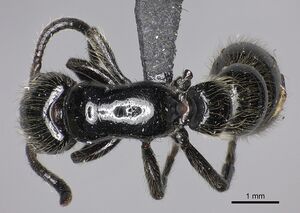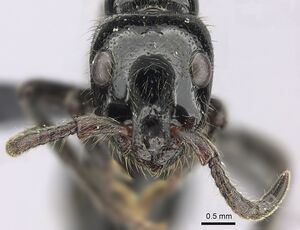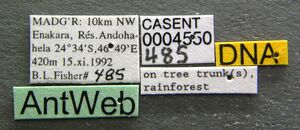Simopone dux
| Simopone dux | |
|---|---|

| |
| Scientific classification | |
| Kingdom: | Animalia |
| Phylum: | Arthropoda |
| Class: | Insecta |
| Order: | Hymenoptera |
| Family: | Formicidae |
| Subfamily: | Dorylinae |
| Genus: | Simopone |
| Species group: | emeryi |
| Species: | S. dux |
| Binomial name | |
| Simopone dux Bolton & Fisher, 2012 | |
Specimens have been collected in forest habitats.
Identification
A member of the emeryi species group. This species is closely related to Simopone sicaria, but in that species the pronotal dorsal outline, in profile, is more or less evenly curved from front to back and the eye averages larger, as noted in the key. Apart from that, the punctate sculpture of the cephalic dorsum is somewhat more dense, and the individual foveolate punctures average larger in sicaria than in Simopone dux. In dux, roughly on the line between the median ocellus and the anteriormost point of the eye, relatively large foveolate punctures are sparse and tend to be widely spaced; the distances between the punctures averages a puncture diameter and is sometimes more. On the same line in sicaria the foveolate punctures are larger and closer together; the distance between them averages less than a puncture diameter and some are adjacent. Also see the identification section for Simopone rex. (Bolton and Fisher 2012)
Keys including this Species
Distribution
Distribution based on Regional Taxon Lists
Malagasy Region: Madagascar (type locality).
Distribution based on AntMaps
Distribution based on AntWeb specimens
Check data from AntWeb
Countries Occupied
| Number of countries occupied by this species based on AntWiki Regional Taxon Lists. In general, fewer countries occupied indicates a narrower range, while more countries indicates a more widespread species. |

|
Estimated Abundance
| Relative abundance based on number of AntMaps records per species (this species within the purple bar). Fewer records (to the left) indicates a less abundant/encountered species while more records (to the right) indicates more abundant/encountered species. |

|
Biology
|
Castes
Worker
Images from AntWeb
   
| |
| Worker. Specimen code casent0004550. Photographer Shannon Hartman, uploaded by California Academy of Sciences. | Owned by CAS, San Francisco, CA, USA. |
Nomenclature
The following information is derived from Barry Bolton's Online Catalogue of the Ants of the World.
- dux. Simopone dux Bolton & Fisher, 2012: 47, figs. 40-42 (w.m.) MADAGASCAR.
- Type-material: holotype worker, 2 paratype workers.
- Type-locality: holotype Madagascar: 45 km.S Ambalavao, 22°13’S, 47°01’E, 24.ix.1993, BLF691, CASENT0004549, on low vegetation, rainforest (B.L. Fisher); paratypes with same data.
- Type-depository: CASC.
- Distribution: Madagascar.
Unless otherwise noted the text for the remainder of this section is reported from the publication that includes the original description.
Description
Worker
(holotype in parentheses). HL 1.76–2.16 (2.00), HW 1.28–1.78 (1.56), SL 0.62–0.80 (0.72), EL 0.48–0.60 (0.52), PW 1.02–1.35 (1.22), AIIW 0.94–1.26 (1.12), AIIL 0.94–1.12 (1.06), AIIIW 1.17–1.60 (1.42), AIIIL 1.12–1.48 (1.34), WL 2.06–2.60 (2.40), MFL 1.29–1.56 (1.50), CI 73–87 (78), SI 44–48 (46), EL/HW 0.31–0.37 (0.33), EP 1.42–1.70 (1.45), AIIW/AIIL 1.00–1.14 (1.06), AIIIW/AIIIL 1.02–1.13 (1.06) (7 measured).
In full-face view anteriormost points of frontal lobes are very slightly posterior to the level of the midpoint of the shallowly convex anterior clypeal margin. With head tilted slightly back from full-face view the clypeal margin in front of each antennal socket is rounded and prominent and projects very slightly farther forward than the midpoint of the anterior clypeal margin. Frontal carinae in full-face view diverging posteriorly and terminating at about the level of the anterior margins of the eyes. Eyes located behind the cephalic midlength (EP 1.42–1.70). Leading edge of scape with conspicuous projecting setae. In full-face view entire side of head with projecting long setae that are curved anteriorly. In profile entire dorsum of head, and ventral surface, with abundant curved standing setae. Cephalic dorsum between eyes with sparse foveolate punctures on a glossy surface. Anterior and dorsal surfaces of pronotum separated by a weak margination or very feeble carina. In profile the dorsal outline of the pronotum distinctly humped or swollen, the highest point conspicuously in front of the promesonotal suture and the outline distinctly sloping down to the suture. Propodeal dorsum curves evenly into the declivity, without a blunt angle or transverse carina. Promesonotal suture weakly impressed; metanotal groove faint to absent but median pit conspicuous. Mesosoma in dorsal view narrowest across mesonotum (in holotype PW 1.22, width across mesonotum at its midlength 1.02, maximum width across propodeum 1.18). Dorsum of mesosoma with scattered small punctures. Entire mesosoma dorsally with numerous standing setae. Dorsal (outer) surfaces of mesotibiae and metatibiae with standing setae that are curved or inclined toward the apex. Dorsal surface of AII (petiole) meets anterior surface in an angle or a weak transverse carina. Posteriorly the dorsum of AII lacks a carina but a weak transverse impression is usually present above the foramen. In dorsal view the posterior corners of AII extend into projecting sharp angles or small triangular teeth that project laterally or posterolaterally. Lateral surface of AII, below the dorsolateral margin and above the level of the spiracle, without a longitudinal ridge or carina that extends the length of the sclerite. In dorsal view AII and AIII vary from as long as broad to very slightly broader than long; AIV is broader than long. Abdominal tergites AII to AIV with numerous setae that are directed posteriorly and are mostly suberect to subdecumbent. Curved setae numerous and distinct on sternites of AIII and AIV. Abdominal tergites AII to AVI sculptured only with sparse punctures that are mostly minute. Full adult colour black, appendages blackish brown to black; clypeus varies from black to red. In profile sides of body often entirely black but a reddish spot may occur on side of AIII and AIV, and in the type-series a conspicuous red spot is also present on the side of the pronotum.
Type Material
Holotype worker (top specimen of three on pin), Madagascar: 45 km S Ambalavao, 22°13’S, 47°01’E, 785 m, 24.ix.1993, BLF691, CASENT0004549, on low vegn., rainforest (B.L. Fisher) (California Academy of Sciences). Paratypes. 2 workers mounted below holotype on same pin (CASC).
References
- Bolton, B. & Fisher, B.L. 2012. Taxonomy of the cerapachyine ant genera Simopone Forel, Vicinopone gen. n. and Tanipone gen. n. (Hymenoptera: Formicidae). Zootaxa 3283, 1–101 (doi:10.11646/zootaxa.3283.1.1).
References based on Global Ant Biodiversity Informatics
- Bolton B., and B. L. Fisher. 2012. Taxonomy of the cerapachyine ant genera Simopone Forel, Vicinopone gen. n. and Tanipone gen. n. (Hymenoptera: Formicidae). Zootaxa 3283: 1-101.

